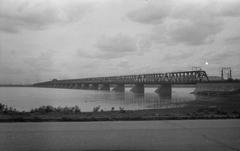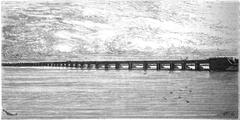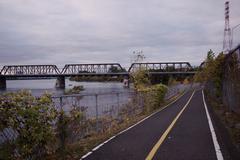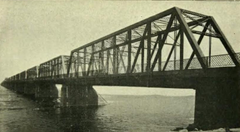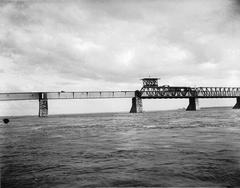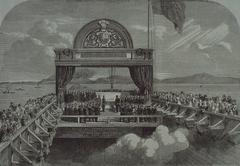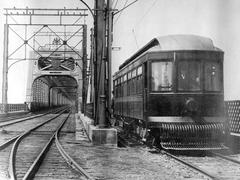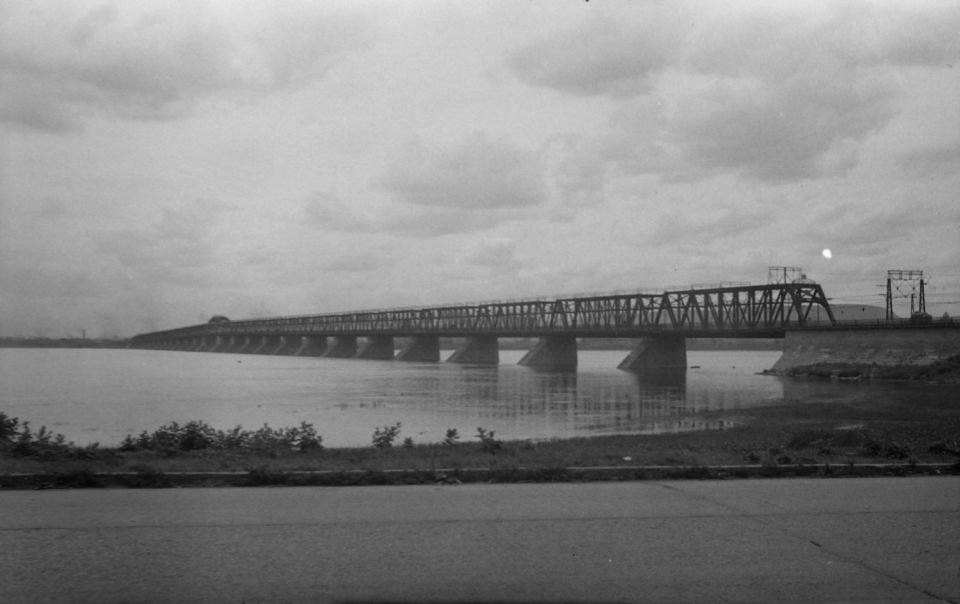
Victoria Bridge Montreal: Visiting Hours, Tickets, and Historical Significance
Date: 14/06/2025
Introduction
Victoria Bridge in Montreal is much more than a vital transportation link—it is a cornerstone of Canadian engineering, a symbol of resilience, and a witness to the city’s transformation from a river-bound settlement to a thriving North American metropolis. Completed in 1859, this bridge was the first to cross the mighty St. Lawrence River, overcoming natural barriers that long hindered trade and travel. Stretching approximately 3 kilometers, Victoria Bridge earned international acclaim as the “8th Wonder of the World” and set new standards in construction and design (CSCE). Today, it remains a crucial artery for both rail and road traffic and a site of profound historical and cultural resonance, especially for the Irish community commemorated by the Black Rock memorial (Montreal Irish Monument Park Foundation).
This comprehensive guide offers visitors essential information, including visiting hours, access policies, nearby attractions, and historical insights to ensure a rewarding experience at this iconic Montreal landmark.
Table of Contents
- Introduction
- Historical Overview and Significance
- Modern Role and Transportation
- Visiting Victoria Bridge: Hours, Tickets & Access
- Best Viewing Points and Photography Tips
- Nearby Attractions and Guided Tours
- Cultural and Historical Insights
- Events and Seasonal Considerations
- Safety and Practical Tips
- Accessibility
- FAQ
- Conclusion
- References
Historical Overview and Significance
Engineering Marvel and Innovations
Victoria Bridge was a groundbreaking feat when it opened in 1859. Designed by Robert Stephenson, it was the world’s longest bridge at that time and the first to span the St. Lawrence River (Wikipedia). Its original tubular wrought iron design, assembled with more than 3 million rivets and 23,000 tons of iron shipped from England, showcased pioneering engineering (McCord Museum). The bridge featured 24 stone piers with angled “ice-breaking noses” to withstand the river’s harsh winters—a design element that influenced future cold-climate bridges (CBC).
In the late 1890s, the bridge was rebuilt as a metal truss structure to handle heavier rail and road loads, further extending its service life and utility (CSCE; Parks Canada).
Technological advancements included steam-powered cranes, derricks, and just-in-time delivery of prefabricated parts from England, setting benchmarks for large-scale infrastructure projects in North America (Parks Canada).
Economic and Social Impact
Victoria Bridge’s completion ended Montreal’s winter isolation and firmly integrated the city into the continental railway network. It allowed for uninterrupted movement of goods and people, transforming Montreal into a major North American transportation hub (Transportation History). The bridge was essential to the success of the Grand Trunk Railway, connecting Montreal to seaports and key cities such as Toronto and Chicago, and expanding the city’s economic reach beyond fur and whiskey to include flour, sugar, and manufactured goods (CBC).
The improved connectivity spurred urban growth, expanded business opportunities, and fostered Montreal’s ascent as Canada’s leading metropolis (The Canadian Encyclopedia).
Symbolism and National Identity
Dedicated to Queen Victoria, the bridge was a source of imperial pride and technological optimism. Its inauguration in 1860 was attended by the Prince of Wales (the future King Edward VII), underscoring its symbolic importance to Canada and the British Empire (Transportation History). The bridge is recognized today as a National Historic Civil Engineering Site (CSCE) and remains a powerful emblem of Canadian ingenuity.
Modern Role and Transportation
Victoria Bridge continues to serve as a critical transportation corridor. It carries Canadian National Railway trains and vehicular traffic (Route 112), with rails at the center and two roadways on its flanks (Wikipedia).
Traffic management is tailored to daily commuting patterns:
- Morning (5:00–9:00 AM): Both lanes northbound into Montreal.
- Evening (3:00–7:15 PM): Both lanes southbound to the South Shore.
- Other times: One lane open in each direction; restrictions may apply for maintenance (Ville de Montréal).
The 1958 St. Lambert Diversion, part of the St. Lawrence Seaway project, allows bridge traffic to continue even when ships are passing through the St. Lambert Locks (Wikipedia).
Visiting Victoria Bridge: Hours, Tickets & Access
Visiting Hours and Ticket Information
Victoria Bridge is primarily a transportation artery—not a dedicated tourist attraction—so there is no admission fee or ticket required for pedestrian or cycling access. However, pedestrian and cycling access is generally available seasonally from April to November, typically from 6:00 AM to 11:00 PM. Always check the official Montreal city website for up-to-date information.
- Vehicular Access: Restricted during rush hours; observe lane direction signage (Ville de Montréal).
- Pedestrian/Cycling Path: Open seasonally, but no walkway is available on the bridge itself for pedestrians. Cyclists must be experienced due to narrow lanes and active traffic (Tourisme Montréal).
Accessibility
- Wheelchair Access: The seasonal pedestrian/cycling path is accessible, but its length and exposure may be challenging for some. Public transit options nearby are wheelchair accessible (STM accessibility).
- Pets: Allowed on the path, but must be leashed and cleaned up after.
Best Viewing Points and Photography Tips
- Pointe-Saint-Charles: Views from Lachine Canal bike path and Peel Basin.
- Saint-Lambert Locks: Panoramic perspective, especially in summer.
- Parc Jean-Drapeau and Parc de la Cité-du-Havre: Excellent for sunrise and sunset photos.
- Old Port of Montreal: Distant but scenic views (Old Port Montreal).
Photography Tips:
- Early morning and late afternoon provide optimal lighting.
- Consider a St. Lawrence River cruise for unique angles (Croisières AML).
- Use high-quality images with descriptive alt text for accessibility and SEO.
Nearby Attractions and Guided Tours
Pair your visit with these experiences:
- Old Montreal: Historic streets and landmarks like Notre-Dame Basilica (Girl with the Passport).
- Lachine Canal: Bike or stroll along the waterway (Parks Canada).
- Atwater Market: Perfect for riverside picnics (Mint Notion).
- Saint-Lambert Village: Explore shops and cafes on the South Shore.
While there are no dedicated guided tours of the bridge, some walking tours of Old Montreal and river cruises include information and views of Victoria Bridge.
Cultural and Historical Insights
The Black Rock Memorial
Located near the Montreal entrance, the Black Rock is a poignant monument marking the mass grave of over 6,000 Irish immigrants who perished from typhus in 1847. The memorial is the focus of annual Irish commemorative ceremonies each May (Montreal Irish Monument Park Foundation).
Victoria Bridge’s Place in Montreal’s Identity
The bridge is not just infrastructure—it is a symbol of Montreal’s evolution and multicultural heritage, appearing in art, literature, and local lore.
Events and Seasonal Considerations
- Irish Commemoration Walk: Held each May at the Black Rock.
- Bridge Closures: Occasional closures for maintenance or special events, mainly during summer; check advisories (Ville de Montréal).
- Montreal Festivals: Plan your visit around city events like the Jazz Festival or MURAL Festival for a richer experience (MTL.org).
Safety and Practical Tips
- Observe all traffic signage and lane directions.
- Do not attempt to walk on the main bridge deck; use viewing paths.
- Dress for variable weather, especially wind on the river.
- No public restrooms on the bridge—use facilities in nearby parks or cafes.
- Carry water and snacks; pack out all trash.
Accessibility
- Public Transit: Accessible metro and bus routes nearby; Charlevoix (Green Line) is the closest station on the Montreal side (Exo).
- Parking: No dedicated lots; use street parking in Pointe-Saint-Charles or Saint-Lambert.
Frequently Asked Questions (FAQ)
Q: What are Victoria Bridge’s visiting hours?
A: The bridge is open to vehicles according to rush-hour schedules; the pedestrian/cycling path is typically open from April to November, 6:00 AM to 11:00 PM.
Q: Are tickets required for Victoria Bridge?
A: No, both vehicular and pedestrian/cycling access are free.
Q: Can I walk or cycle across Victoria Bridge?
A: Pedestrian access is not available; cycling is permitted for experienced riders on the seasonal path.
Q: Is the bridge wheelchair accessible?
A: The path is accessible but lengthy; public transit options nearby are also accessible.
Q: Where are the best photo spots?
A: Pointe-Saint-Charles, Saint-Lambert Locks, Old Port, and Parc Jean-Drapeau.
Conclusion
Victoria Bridge stands as a living chapter in Montreal’s and Canada’s story—an engineering marvel, a driver of economic transformation, and a symbol of multicultural resilience. While its primary role is as a transportation link, the bridge’s historical and cultural legacy is accessible through nearby vantage points, the Black Rock memorial, and related attractions. For a well-rounded visit, combine your trip with local parks, Old Montreal, and river cruises, and check advisories before planning your route.
For more travel tips and up-to-date guides, download the Audiala app and explore our related articles. Share your experiences and photos with us to celebrate Montreal’s vibrant heritage.
References and Resources
- Victoria Bridge (Montreal), Wikipedia
- Canadian Society for Civil Engineering – Victoria Bridge
- Montreal’s Victoria Bridge Marks 150 Years, CBC News
- Victoria Bridge National Historic Site, Parks Canada
- The Victoria Bridge in Canada Makes Its Formal Debut, Transportation History
- Victoria Bridge, The Canadian Encyclopedia
- Victoria Bridge Virtual Exhibit, McCord Museum
- Montreal Irish Monument Park Foundation
- Ville de Montréal – Victoria Bridge
- Old Port of Montreal
- Croisières AML (St. Lawrence River Cruises)
